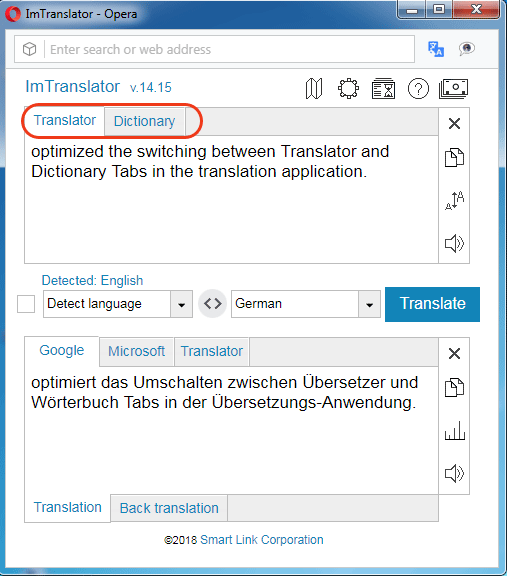Home » Add-ons » ImTranslator for Opera
ImTranslator for Opera
Download ImTranslator Extension for Opera from the Opera extensions catalog. After the installation, the ImTranslator button appears on the Opera toolbar and in the Opera context menu.
Extension for Opera
ImTranslator v. 14.15 extension for Opera
What's new in this version:
- optimized the switching between Translator and Dictionary Tabs in ImTranslator application. Synchronization of the source text
- updated Chinese Traditional localization
ImTranslator for Opera offers a selection of translation applications:
as well as convenient language tools such as Text-to-Speech, Translation History and ImTranslator Dictionary.
Extension for Opera
Functionality
- instant translation between more than 100 languages
- 3 translation providers (Google, Microsoft, Translator)
- 4 translation applications
- translation in a pop-up bubble window (Pop-up Bubble Translator)
- standalone translator switching between Translator and Dictionary modes (ImTranslator)
- translation inserted into a webpage (Inline Translator)
- translation of the entire webpage with mouseover translation option (Webpage Translation)
- ImTranslator Dictionary
- text-to-speech in many languages
- translation history
- automatic language detection
- back translation
- shortcuts customization
- complete customization of each translation tool
- user interface in English, Chinese, Czech, Dutch, Filipino, French, German, Greek, Italian, Hindi, Korean, Polish, Portuguese, Romanian, Russian, Spanish, Swedish, Turkish, Vietnamese, Ukrainian languages.
Inline Translator translates selected text sentence-by-sentence, and inserts the translation into a webpage preserving the original formatting. Based on settings, the translation can be placed before or after the selected text, or even replace the original.
To see the inline translation result, follow these steps:
- select the text with the mouse, and use the context menu
 ImTranslator: Translator, Dictionary, TTS, then choose Inline Translation
ImTranslator: Translator, Dictionary, TTS, then choose Inline Translation - or use the shortcut keys Ctrl+Alt+C (default)
Pop-up Bubble Translator translates words, sentences and text on any website using various translation providers, and displays the translation in a pop-up bubble without leaving the page.

You can run the Pop-up Bubble translator in a number of ways.
Select the text on a webpage with the mouse and:
- click the
 floating button
floating button - use the context menu
 ImTranslator: Translator Dictionary, TTS, then Pop-Up Bubble
ImTranslator: Translator Dictionary, TTS, then Pop-Up Bubble - translate on mouse selection only (remove the shortcut in the Pop-up Bubble Options)
or use the shortcut keys Ctrl+Alt (default) before or after selecting the text with the mouse.
You will see the translation in a pop-up bubble above the selected text. By default, ImTranslator Bubble automatically detects the language of the selected text, so all you have to do is to select the target language to translate.
ImTranslator is a standalone application that translates words, sentences and texts using 3 translation providers Google Translate, Microsoft Bing Translator and Translator.
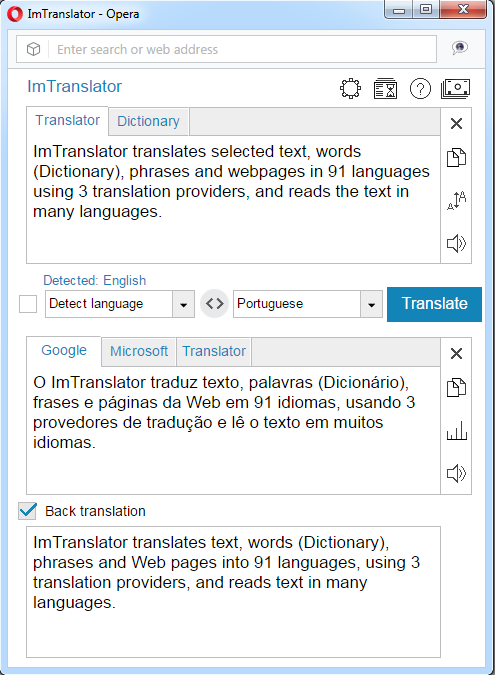
To run the application, do the following:
- click
 ImTranslator: Translator, Dictionary, TTS button on the Opera toolbar, or
ImTranslator: Translator, Dictionary, TTS button on the Opera toolbar, or - choose ImTranslator from the Opera context menu
 ImTranslator: Translator, Dictionary, TTS, or
ImTranslator: Translator, Dictionary, TTS, or - use the shortcut keys Ctrl+Alt+Z (default).
To translate: enter, paste, or drag-n-drop the text to the "Original text" window. Choose the translation direction and the translation provider, and click Translate.
You can switch between the Translator and Dictionary modes using corresponding tabs, or simply enter a word to get to dictionary's translation mode.
Webpage Translation translates an entire webpage using Google Translate service. To translate a webpage, choose “Translate this page to” a selected language from the context menu ![]() ImTranslator: Translator, Dictionary, TTS.
ImTranslator: Translator, Dictionary, TTS.

The context menu provides the choice of the webpage translation modes:
- translate an entire webpage (Ctrl+Alt+P)
- mouseover translation of a text segment on the page (Ctrl+Alt+M)
When you choose the mouseover translation mode, hover your mouse over the original text, and the translation for the highlighted segment will be displayed in a pop-up window.
The context menu allows you to change the translation language using the "Change language" menu. You can also change the translation language from the translation toolbar on the top of the webpage.

ImTranslator Dictionary translates singles words and displays alternative translations along with their part of speech. In addition to the translation variants, each dictionary entry displays a set of reverse translations into the original language, if available.
All dictionary's entries have the voice feature depending on the language (30 voices available).

The Dictionary translations can be viewed in ImTranslator application, Pop-up Bubble Translator or Inline Translator.
The translation of words is provided by the Google Translate dictionary. Make sure to select Google Translator (G) to see dictionary's translations.
The feature "Words translation on double-click" opens the Pop-up Bubble with the dictionary's translations.
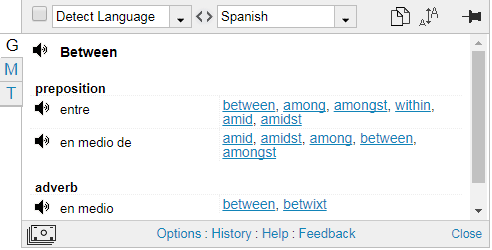
ImTranslator offers text to voice conversion for 30 languages. You can listen to the original text or its translation by clicking the Listen icon next to the corresponding text box.

Use the Advanced Settings to choose which text-to-speech service to use: ImTranslator TTS or an alternative TTS service.
Translation History keeps track of all your translation activity and stores translation records in the Translation History database.
To access Translation History click the History link on each translation tool, or use ImTranslator Options, then Translation History panel.
The translation records from ImTranslator, Pop-up Bubble and Inline Translator are stored as the original text with its translation, while the translation history from the Webpage Translation is stored as links to the original page and the translated page.
Languages
Afrikaans, Albanian, Amharic, Arabic, Armenian, Azerbaijani, Basque, Belarusian, Bengali, Bosnian, Bulgarian, Catalan, Cebuano, Chichewa, Chinese (simplified), Chinese (traditional), Corsican, Croatian, Czech, Danish, Dutch, English, Estonian, Esperanto, Filipino, Finnish, French, Frisian, Galician, Georgian, German, Greek, Gujarati, Haitian Creole, Hausa, Hawaiian, Hebrew, Hindi, Hmong, Hungarian, Icelandic, Igbo, Indonesian, Irish, Italian, Japanese, Javanese, Kannada, Kazakh, Khmer, Korean, Kurdish, Latin, Latvian, Lithuanian, Macedonian, Malagasy, Malay, Malayalam, Maltese, Maori, Marathi, Mongolian, Myanmar (Burmese), Nepali, Norwegian, Pashto, Persian, Polish, Portuguese, Punjabi, Romanian, Russian, Samoan, Scots Gaelic, Serbian, Sesotho, Shona, Sindhi, Sinhala, Slovak, Slovenian, Somali, Spanish, Sundanese, Swahili, Swedish, Tajik, Tamil, Telugu, Thai, Turkish, Ukrainian, Urdu, Uzbek, Vietnamese, Welsh, Yiddish, Yoruba, Zulu
Download ImTranslator Extension for Opera from the Opera extensions catalog. After the installation, the ImTranslator button appears on the Opera toolbar and in the Opera context menu.
Extension for Opera
Languages
Afrikaans, Albanian, Amharic, Arabic, Armenian, Azerbaijani, Basque, Belarusian, Bengali, Bosnian, Bulgarian, Catalan, Cebuano, Chichewa, Chinese (simplified), Chinese (traditional), Corsican, Croatian, Czech, Danish, Dutch, English, Estonian, Esperanto, Filipino, Finnish, French, Frisian, Galician, Georgian, German, Greek, Gujarati, Haitian Creole, Hausa, Hawaiian, Hebrew, Hindi, Hmong, Hungarian, Icelandic, Igbo, Indonesian, Irish, Italian, Japanese, Javanese, Kannada, Kazakh, Khmer, Korean, Kurdish, Latin, Latvian, Lithuanian, Macedonian, Malagasy, Malay, Malayalam, Maltese, Maori, Marathi, Mongolian, Myanmar (Burmese), Nepali, Norwegian, Pashto, Persian, Polish, Portuguese, Punjabi, Romanian, Russian, Samoan, Scots Gaelic, Serbian, Sesotho, Shona, Sindhi, Sinhala, Slovak, Slovenian, Somali, Spanish, Sundanese, Swahili, Swedish, Tajik, Tamil, Telugu, Thai, Turkish, Ukrainian, Urdu, Uzbek, Vietnamese, Welsh, Yiddish, Yoruba, Zulu
ImTranslator Options provide a perfect way to customize ImTranslator application according to your needs.


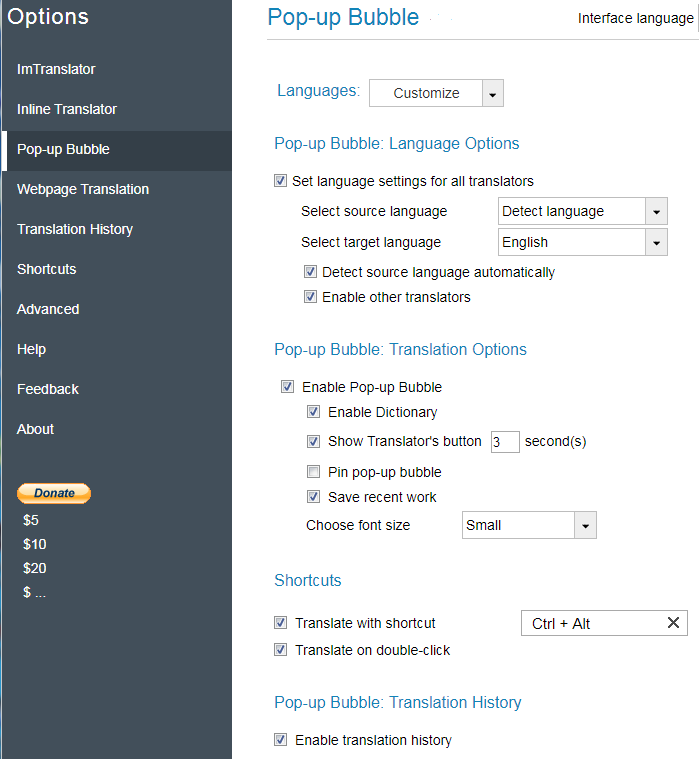
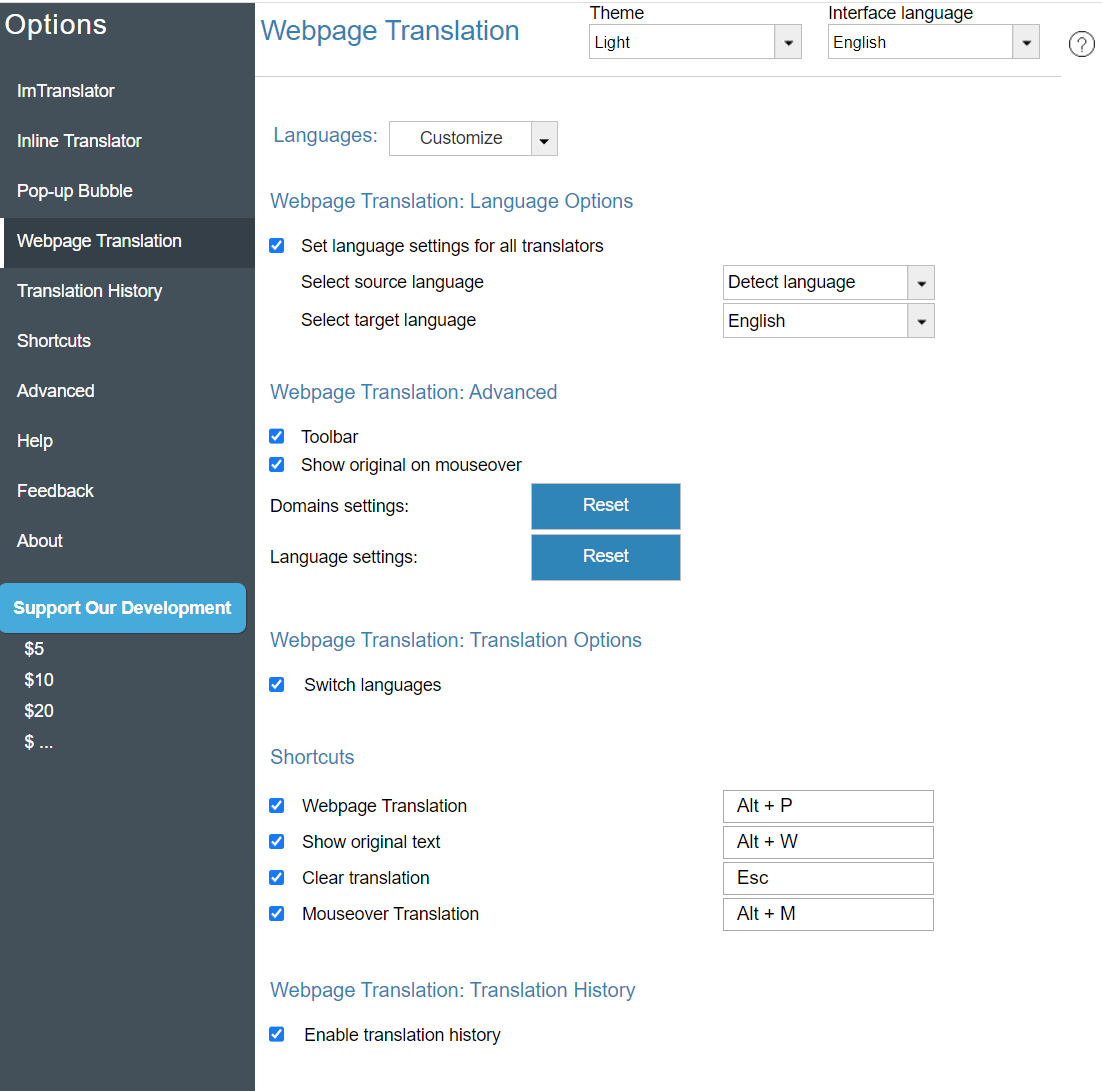

To access the Translation History click the History link on each translation tool, or go to ImTranslator Options, then Translation History panel.
The translation records from ImTranslator and Pop-up Bubble are stored as an original text and its translation, while the translation history from Web Translation is stored as links to the original page and the translated page.
What you can do with Translation History
- expand the translation record if it's over 200 characters
- split the record by sentences to display sentence-by-sentence translation
- see the source of the translation
- search and sort translation records
- listen to the original or translation
- export the translation history in .csv format
- delete records
- clear all history
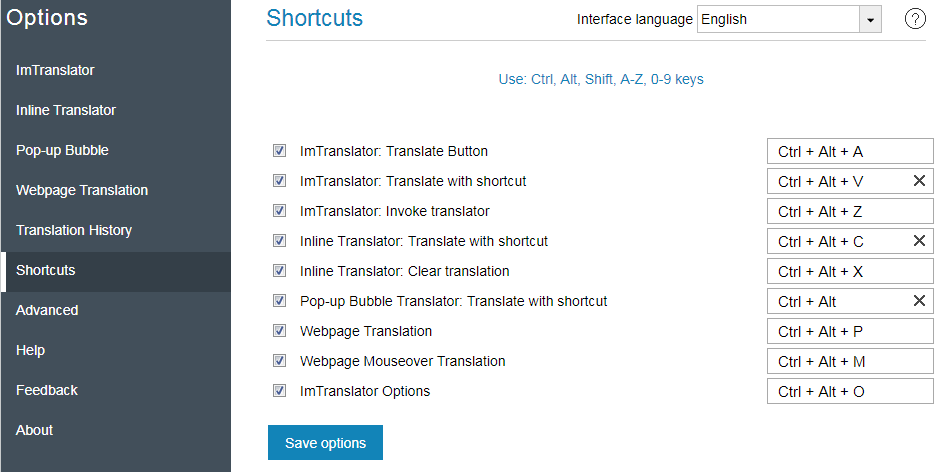
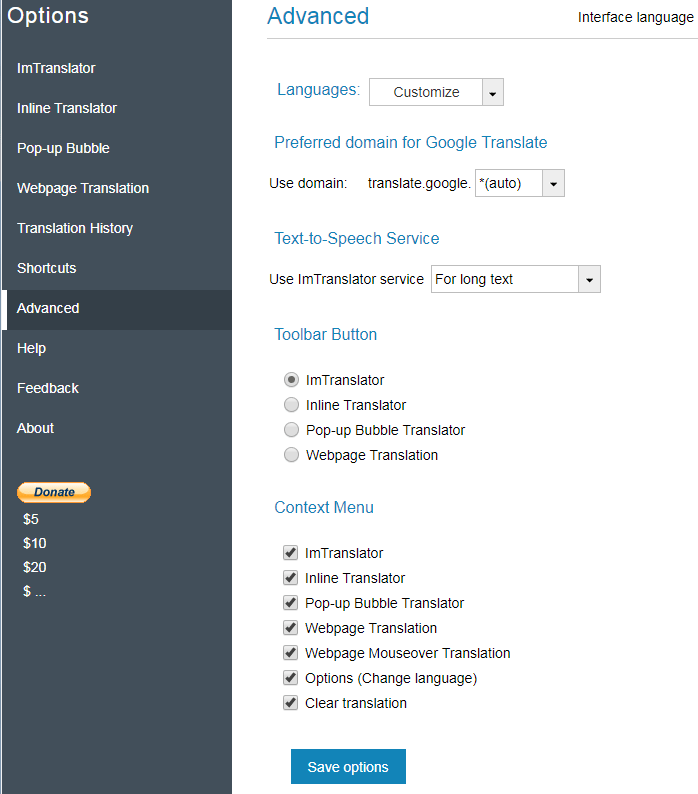
Advanced Settings allow you to adjust ImTranslator Options to accommodate your preferences. Choose which TTS service to use: ImTranslator TTS service or the TTS service from other providers.
ImTranslator for Opera Tutorial
ImTranslator performs an instant translation of words, phrases, texts and webpages between 91 languages.

Then it inserts the translation into a webpage after or before the original sentence, or simply replaces the selection.
ImTranslator becomes immediately available as a button on the toolbar. To start using ImTranslator select the text on the webpage and click "ImTranslator: Translator, Dictionary, TTS" button on the Opera toolbar, or simply use the shortcut keys Ctrl+Alt+Z (default) to open ImTranslator application.

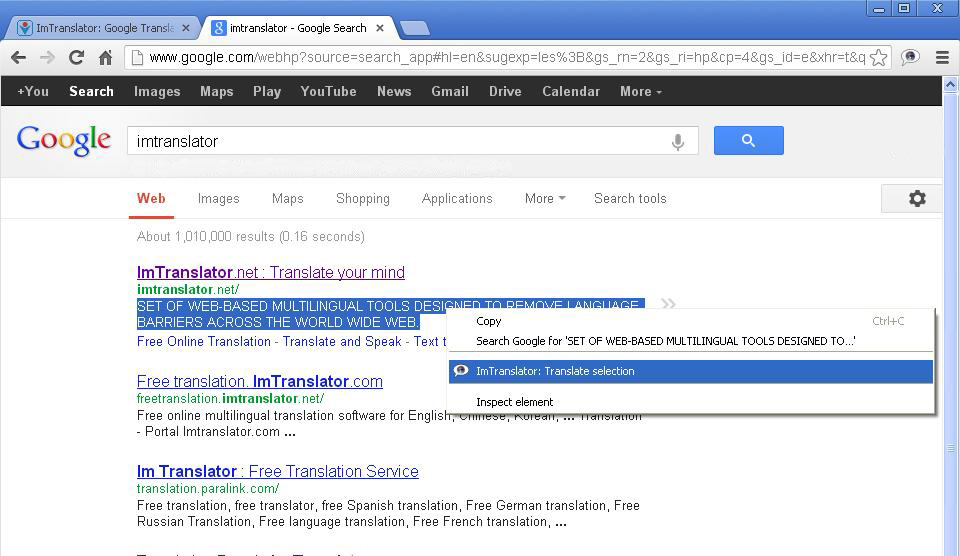
You will see ImTranslator standalone application popping up with the original text and its translation.
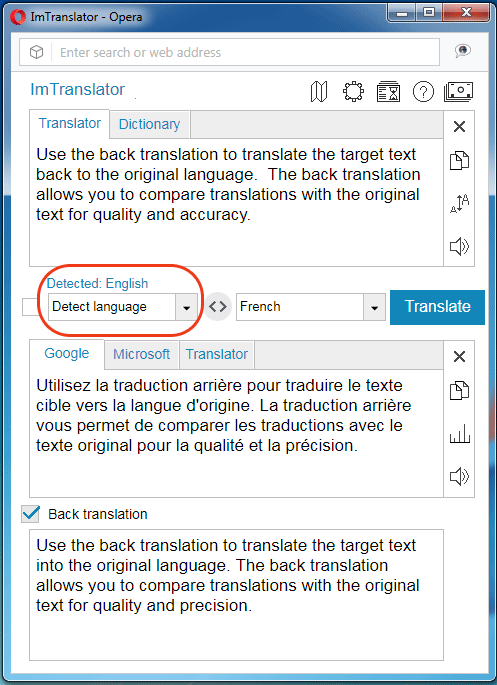
When the automatic language detection is performed, the "Detected: language" label will appears.

Comparison of the back-translation to the original text is sometimes used as a quality check on the original translation.
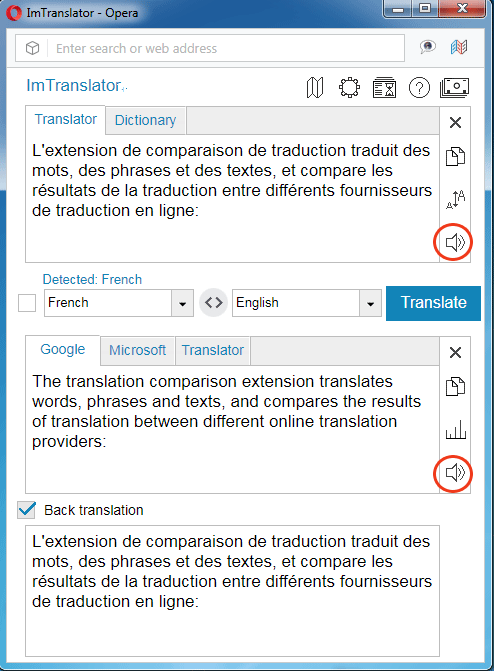
This feature is currently available for 30 languages.

The Dictionary covers over 90 language combinations with English language and other language pairs. The Dictionary is available in ImTranslator, Pop-up Bubble or Inline Translator applications.
If you select more than one word to translate, you will get the regular translation done by Google Translate.


To translate using the Pop-up Bubble, select a text on a webpage with the mouse and click the floating button. Or hold the shortcut keys Ctrl + Alt (default) while selecting the text to translate.
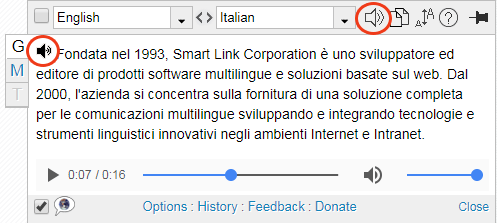
Click the "Listen" icon on the toolbar to initiate the voice.
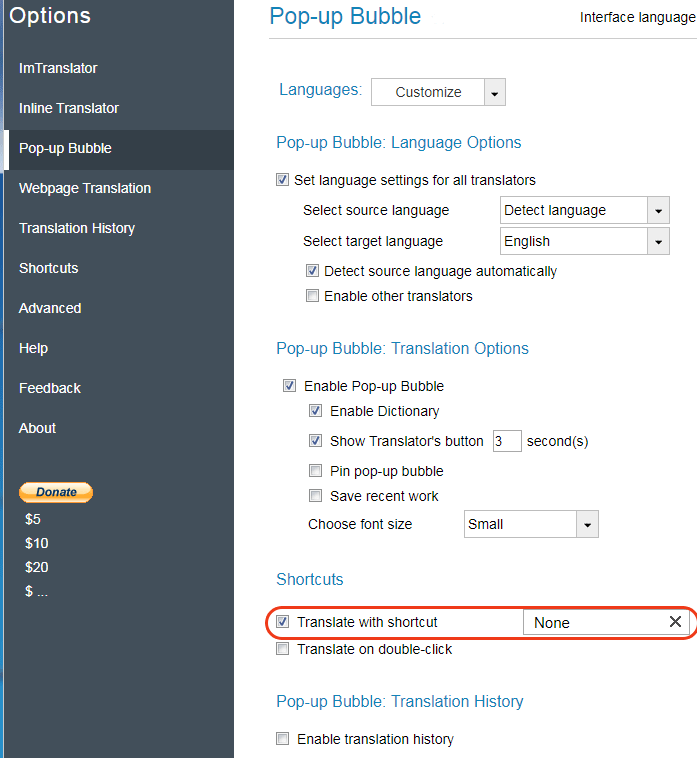
ImTranslator Bubble can be customized in this window. You can choose to run ImTranslator Bubble via the floating button, or with/without the shortcut key. You can choose to pin ImTranslator Bubble to the right side of the webpage, as well as change the font size (small or large). Here you can also enable the Translation History.

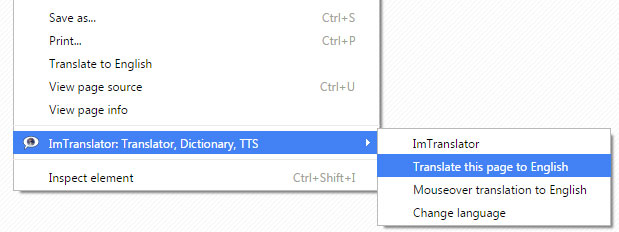
The context menu provides the choice of a web page translation mode: translate the entire web page or mouseover translation. From this menu you can change the translation language.

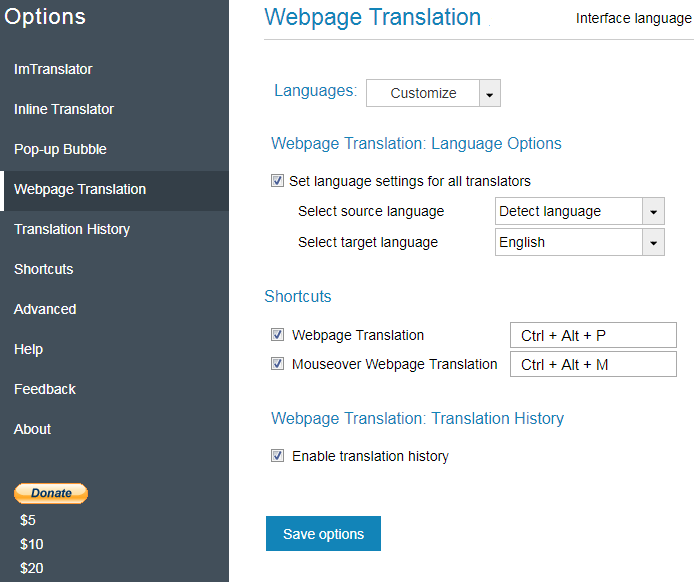
If you check mark the box "Set language settings for all translators", the preferred translation direction will be available for all translation tools.

To access Translation History click the History link on each translation tool, or go to ImTranslator Options, then Translation History tab.
What you can do with Translation History:
- expand the translation record if it's over 200 characters
- split the record by sentences to display sentence-by-sentence translation
- see the source of the translation
- search and sort translation records
- listen to the original or translation (10 languages)
- export the translation history in .csv format
- delete records
- clear all history

